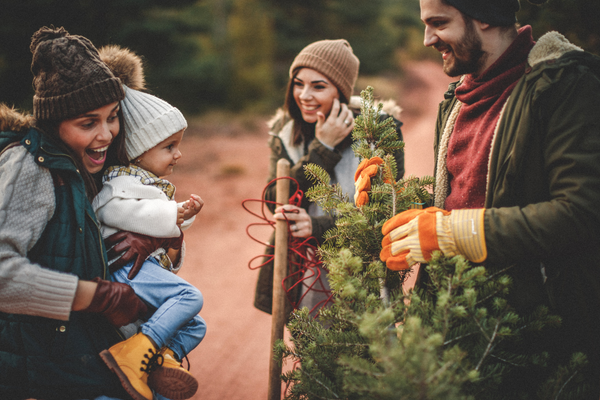We spend a lot of time talking about the benefits of trees and why you shouldn’t cut down trees, but you may be wondering, what about about Christmas trees? Are Christmas trees eco-friendly? Are real Christmas trees better for the environment? Or is it better to purchase a fake Christmas tree to save the real trees from being cut down?
We’re here to alleviate these concerns for all Christmas-loving environmentalists by answering this question and more. And if you want to further reduce your environmental impact this holiday season, you can also check out our tips for a sustainable holiday!
Are Fake Christmas Trees Bad For the Environment?
Artificial trees can last many years if well cared for, which seems to make them the obvious sustainable choice, but they do have drawbacks. Because most are made with plastic and metal materials, they take a lot of resources to create — and their plastic components will exist for thousands of years, polluting our oceans and filling the bellies of sea turtles.
Often produced and shipped from China, they also have a hefty carbon footprint — to the tune of up to 88lbs of CO2 per artificial tree, which is over 10X higher than that of a sustainably grown, properly recycled real Christmas tree.
In fact, you would have to keep your fake Christmas tree for at least 10 years for it to have the same carbon impact as using a real tree each year — and that isn’t considering the environmental damage artificial trees cause as they slowly break down in a landfill. And let’s be real: the likelihood of them lasting 10 years before breaking or getting thrown out is pretty low.

Are Real Christmas Trees Better For the Environment?
Yes, real Christmas trees are more eco-friendly and a better choice for the environment. It may feel counter-intuitive, but it’s much more sustainable to cut down a real tree each year. That’s because most small-scale Christmas tree farms are inherently sustainable, leaving certain sections open for harvesting every year, while keeping other areas closed to give younger trees a chance to grow.
It takes around 7 years to grow an average-sized Christmas tree, and as trees grow, they absorb carbon and use 10x fewer resources than artificial tree factories. According to the Association of Christmas Tree Growers, for every tree that is cut down each year, 1 to 3 new seedling trees are planted.
This rotating cycle ensures that the farmers will have a steady harvest of salable trees every year, but it also provides habitat for wildlife and protects the land from getting used for other purposes. In fact, many Christmas tree growers utilize steep hillsides that would otherwise be unsuitable for agricultural activities.
In short: sustainable Christmas tree farms are both the ethical and sustainable choice: they can be great for the environment and for the people who work and live on them, for whom jobs and income are generated. And of course, unlike fake trees, real trees are completely biodegradable and can be used for lumber, turned into mulch, donated to restoration projects, composted and used to fertilize next year’s crop, and more!

Do All Real Christmas Trees Have the Same Environmental Impact?
Unfortunately, there are bad actors out there that cut trees from primary forests, which means that not at all real Christmas trees have the same environmental impact. But if you’re willing to spend a little time researching, you likely can find a small tree farm near you where you’ll be able to see exactly where and how the trees are grown and managed.
Real Christmas trees, like any houseplant, help clean the air inside your home by removing dust and pollen from the air. So you’ll also be improving your indoor air quality, which is often reduced once everything gets sealed up for winter.
Of course, you could also go full-on hippie and find a sustainable alternative Christmas tree, or get a live tree that can then be planted outdoors after the holidays (just make sure it’s a native tree species suited to your natural climate). You could even bedazzle that massive fern in your living room. We won’t judge!

How to Recycle Your Real Christmas Tree
Once the holiday season is over, there are plenty of options for properly disposing of your Christmas tree:
- Participate in a local tree recycling program if there’s one in your area
- If you have a wood chipper, chip the tree for free mulch
- Donate it to a local environmental organization, who may repurpose it for restoration projects like beefing up riparian areas, protecting fragile dunes, sheltering wildlife and more.
- Use the needles for crafts like evergreen potpourri, the trunk for natural coasters and more!
- Strip the tree bare and use it to build a frame for vine-y garden plants like beans, cucumbers and flowers
- Secure the tree outside in a spot that’s sheltered from wind to provide a winter shelter for small mammals and more!
And finally, if you’re still worried about your holiday impact, consider planting a tree with us to offset your Christmas tree!
